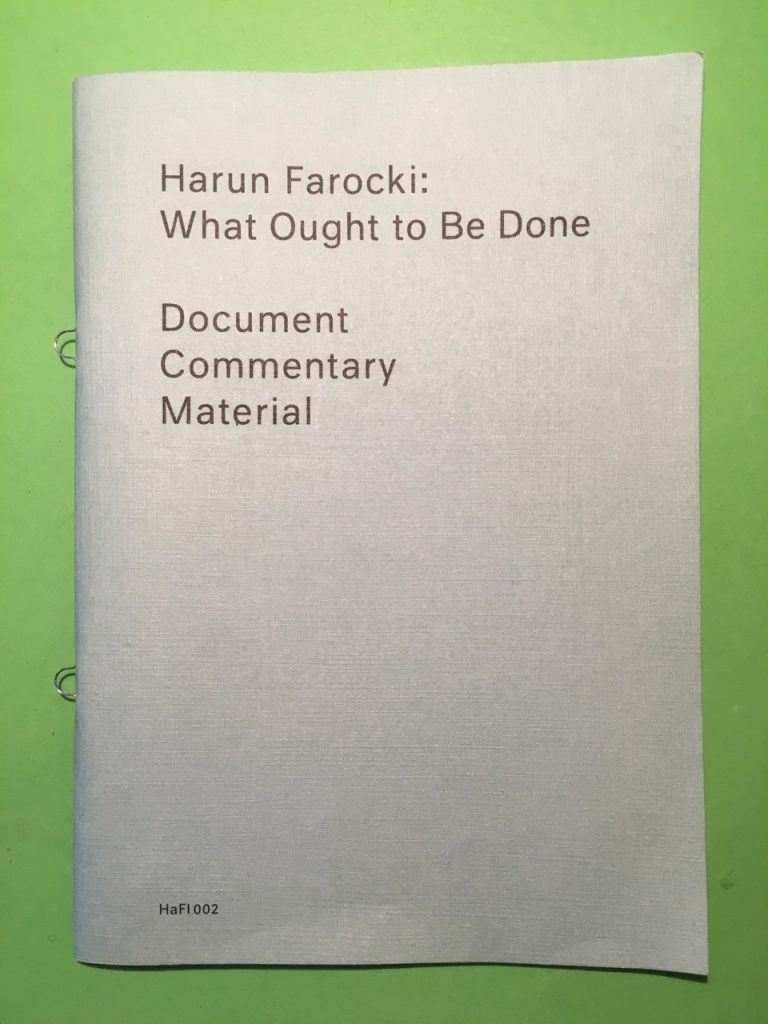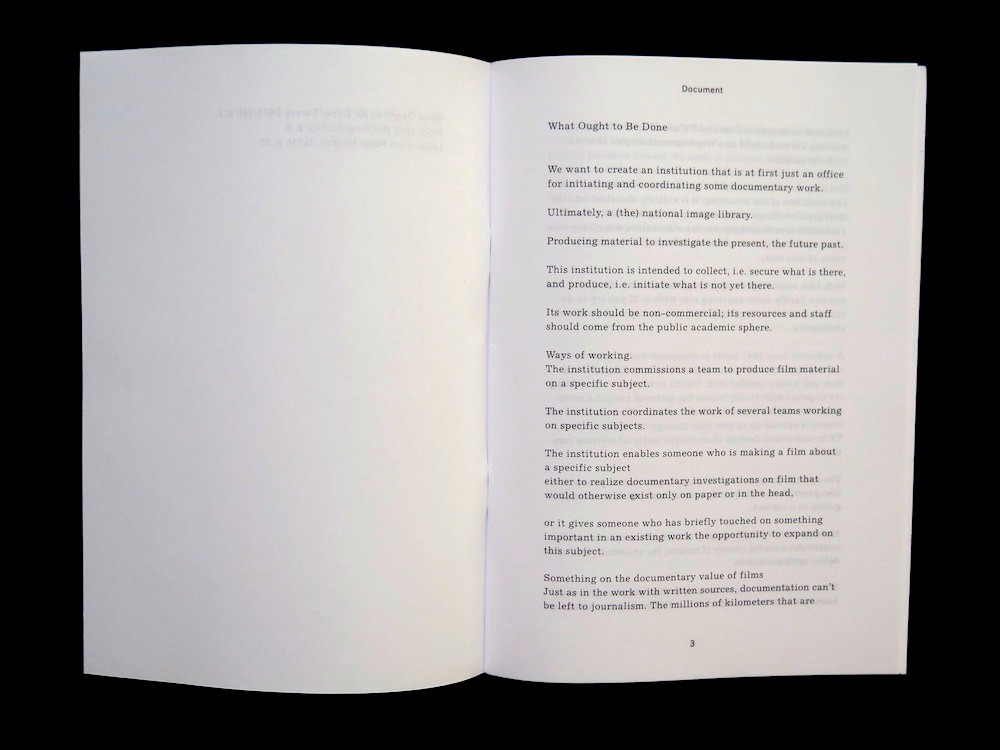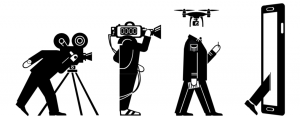
This is one of the initial publications issued by the Harun Farocki Institut, a proposal written by Harun Farocki in 1975-76 calling for the establishment of an institution dedicated to a new mode of documentary practice. It would be forty years later, and two years following his passing, that his vision would materialize in the form of the Farocki Institut.
The publication is organized into three parts: “Document” refers to Farocki’s letter; “Commentary” refers to an accompanying essay by HaFI co-directors Tom Holert, Doreen Mende and Volker Pantenburg providing historical context for the letter; and “Material” refers to an additional letter written by filmmaker Peter Nestler in response to Farocki’s. This may not have been the intention of the publishers, but as I interpret it, this cover could be read as Farocki’s procedure for how to produce documentary work:
What Ought To Be Done: Document-Commentary-Material
- Document: observe, record, collect, secure.
- Commentary: study, reflect, analyze, critique.
- Material: synthesize, produce, create, enact.
Extrapolating further, the third stage is reached through the dialectic engagement between the first two stages: the mind struggling with the matter.

As to Farocki’s actual letter, I take some key points from his outline for the institute-to-be:
“Its work should be non-commercial; its resources and staff should come from the public academic sphere.”
And later:
“Just as in the work with written sources, documentation can’t be left to journalism.”
I don’t know if there’s a direct correlation between these statements, but if journalism wasn’t within the domain of the commercial sector back in 1970s Germany, it certainly is today around the world (just as the “public academic sphere” has less economic wherewithal to support cultural initiatives than it may have had 40 years ago). And it has definitely produced a warped view of reality as a commercial product to be continuously packaged and sold, making it the more necessary for efforts to be made to provide for independent and critically-minded relations with images and reality, free from the restrictions of commercialism and other prevailing agendas of our time.
As the authors of the commentary put it: “The ‘institution’ proposed by Farocki was intended to facilitate other, social and collaborative processes, comprehensive and interdisciplinary studies without time pressure, works that take the ‘documentary value of films’ seriously.” This statement puts specific emphasis on the relationship between time and the production of truly substantive documentary work, which in Farocki’s view is distinguishable from the work of journalism precisely because journalism is limited in its capacity to produce an insightful, sustained engagement with its subject due to its working within short, restrictive windows of time. “The specific purpose of utilization/expression in journalism also prevents the adequately intense and continuous investigation of a subject.”
I would add that to overcome the limitations ascribed to the journalistic mode is not just a matter of being liberated from time pressure, but also the pressures and motivations of commercial profit, social conformism, and other conveniently prescribed and hyper-utilitarian mechanisms of understanding that actually limit our ability to understand.
Pushing in the opposite direction, Farocki advocates a more complicated approach: speaking of an archival component to the institute, he describes his idea of an archive more as an investigative, self-critical endeavor. “Not enough research is being done on what really constitutes a useful library of images.” He sees the archive not simply as a functioning system but something that can account for “the systematic and what defies systemization.”
In a similar vein, his language in this letter tends towards evocative but vague aphorisms: “Images must be made with which today’s strange world can be discovered and the present becomes history. We need to produce building blocks. First we need to develop them, and then we have to assemble and disassemble.”
But there’s one specific example that brings his point into clear focus: “A newsreel from 1947 tends to document how a newsreel was cut and spoken at the time, rather than how things looked then and what a speaker said.” This shift of attention of the documentary viewer from the subject itself to the way the subject is presented exemplifies another defining characteristic of what we might refer to as Farockian. In the words o the commentary, “‘What Ought to Be Done’ recalls Farocki’s continual call for visual literacy which would empower people to both read and put together images – as if images constituted a language whose syntax and grammar could be learnt in school from the first grade.”
Indeed, this is exactly what ought to be done now. And yet the challenge to do so in a systemic, institutional manner seems more daunting than ever due to the accelerated pace of change in visual culture. In my present research I encountered a conference talk on the effect of terrorist media on children. The speaker called upon a revamping of educational programs to address the emerging challenges of our time: “We have to expand an antiquated media literacy curriculum that exists in many K-12 schools, if at all, to one that explores the startling revolutions that have occurred, some within recent years, in our online, social media, digital, visual, interactive media world.”
It’s a statement of urgency as well as anxiety, informed by the very time pressure that the custodians of the Farocki Institute seek to alleviate. How then may one address the challenges of our time – many of which are tied to the contemporary experience of time itself – in a way that can be liberated from and can liberate others from the oppression of time?
Perhaps we can take confidence in any instance where the right step is taken, and what ought to be done indeed gets done, however much time it takes. From this perspective, even 40 years isn’t too late.
P.S.: This post was originally meant to be the second entry of this blog back when I first read “What Ought To Be Done” upon my arrival in Berlin in late December. A number of things happened that interfered with that plan, but then again, I don’t think I would have written this entry the same way I would have done two months ago.
